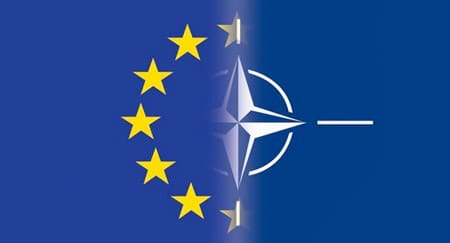Disagreements between some European countries and the United States over policy towards Iraq have generated much media comment during the past year, including speculation about the future of transatlantic relations in general and the relationship between the European Union and NATO in particular. Ironically, however, it has been during this period that EU-NATO relations have moved most rapidly and constructively forward writes Pol De Witte.
The European Union and NATO established formal relations in January 2001 but the breakthrough came on 16 December 2002 with the adoption of the EU-NATO Declaration on ESDP (for full text, see NATO Press Release (2002)142). Since then, the two organisations have negotiated a series of documents on cooperation in crisis management, which made it possible for the European Union to take over from NATO responsibility for peacekeeping in the former Yugoslav Republic of Macedonia* on 1 April.
A set of key cooperation documents, known by insiders as the "Berlin-Plus" package, was agreed by both organisations on 17 March 2003. Five days earlier, an EU-NATO Agreement on Security of Information was signed, allowing the exchange and circulation of classified information and material under reciprocal security protection rules. The term "Berlin Plus" is a reference to the fact that the 1996 meeting where NATO foreign ministers agreed to create a European Security and Defence Identity and make Alliance assets available for this purpose took place in Berlin.
The "Berlin-Plus" arrangements seek to avoid unnecessary duplication of resources and comprise four elements. These are: assured EU access to NATO operational planning; availability to the European Union of NATO capabilities and common assets; NATO European command options for EU-led operations, including developing the European role of NATO's Deputy Supreme Allied Commander, Europe (SACEUR); and adaptation of the NATO defence planning system to incorporate the availability of forces for EU operations.
Modalities have been worked out for the release, monitoring, return or recall of NATO assets and capabilities in EU-led operations. The Deputy SACEUR (who is always a European) may also be the Operation Commander of an EU-led mission. The European Union and NATO have agreed procedures for consultation in the context of an EU-led mission making use of the Alliance's collective assets and capabilities. And agreement has been reached on developing "coherent and mutually reinforcing capability requirements". A joint EU-NATO crisis-management exercise — to test the range of standing arrangements on consultation and cooperation in times of crisis — will take place in November 2003.
The "Berlin-Plus" arrangements are now being put into practice in Operation Concordia, the European Union's first military deployment in the former Yugoslav Republic of Macedonia.* Admiral Rainer Feist, the Deputy SACEUR, is Operation Commander and EU liaison officers are working alongside their NATO colleagues in the NATO command structure, both at the strategic level in an EU cell at SHAPE in Mons, Belgium, and at regional level at AFSOUTH in Naples, Italy. In the field, in Skopje, the Force Commander, a French army general, and his staff are working closely with the NATO Senior Military Representative.
Daily EU-NATO operational coordination is taking place both in Bosnia and Herzegovina (where NATO-led forces are deployed in SFOR and the European Union has a police mission) and in Kosovo (where NATO-led forces are deployed in KFOR and the European Union is responsible for economic reconstruction). Lessons learned from Operation Concordia as well as from the first EU-NATO joint crisis-management exercise this November should help increase the operational effectiveness of the "Berlin-Plus" arrangements and further strengthen the relationship between the two organisations. Moreover, on 25 July 2003, the European Union and NATO agreed a joint approach to stabilising the Western Balkans. (For full text, see NATO Press Release (2003)089 of 29 July 2003).
NATO experts have already been involved in work on the EU Headline Goal in the Headline Task Force Plus for many years. The EU-NATO capabilities group, established in May under the EU-NATO agreement on "coherent and mutually reinforcing capability requirements", seeks to ensure consistency, transparency and mutually reinforcing development of capability requirements common to the two organisations, especially in relation to the EU headline and collective capability goals and NATO's Prague Capabilities Commitment.
In addition, at their 3 June joint meeting, EU and NATO foreign ministers reaffirmed their willingness to develop closer cooperation between the two organisations to combat terrorism and the proliferation of weapons of mass destruction. The European Union and NATO have already exchanged information on their activities in the field of protection of civilian populations against chemical, biological, radiological and nuclear attacks.
The fact that so many far-reaching agreements were negotiated in so short a time is testimony to the commitment of all 23 EU and NATO member states to developing a long-term strategic partnership between the European Union and NATO. With 11 "double-hatted" members, EU and NATO memberships already overlap significantly. Next year, following the enlargement of both organisations, 19 countries will be members of both, which should reinforce cooperation, aimed at avoiding unnecessary duplication and competition between the two organisations.

